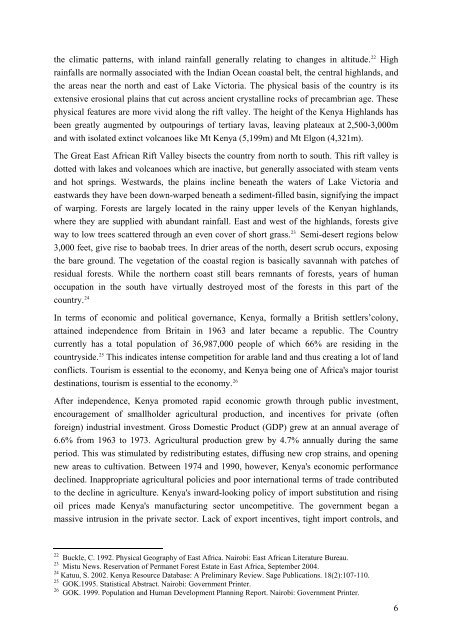THE UNIVERSITY OF LEIPZIG
THE UNIVERSITY OF LEIPZIG
THE UNIVERSITY OF LEIPZIG
You also want an ePaper? Increase the reach of your titles
YUMPU automatically turns print PDFs into web optimized ePapers that Google loves.
the climatic patterns, with inland rainfall generally relating to changes in altitude. 22 High<br />
rainfalls are normally associated with the Indian Ocean coastal belt, the central highlands, and<br />
the areas near the north and east of Lake Victoria. The physical basis of the country is its<br />
extensive erosional plains that cut across ancient crystalline rocks of precambrian age. These<br />
physical features are more vivid along the rift valley. The height of the Kenya Highlands has<br />
been greatly augmented by outpourings of tertiary lavas, leaving plateaux at 2,500-3,000m<br />
and with isolated extinct volcanoes like Mt Kenya (5,199m) and Mt Elgon (4,321m).<br />
The Great East African Rift Valley bisects the country from north to south. This rift valley is<br />
dotted with lakes and volcanoes which are inactive, but generally associated with steam vents<br />
and hot springs. Westwards, the plains incline beneath the waters of Lake Victoria and<br />
eastwards they have been down-warped beneath a sediment-filled basin, signifying the impact<br />
of warping. Forests are largely located in the rainy upper levels of the Kenyan highlands,<br />
where they are supplied with abundant rainfall. East and west of the highlands, forests give<br />
way to low trees scattered through an even cover of short grass. 23 Semi-desert regions below<br />
3,000 feet, give rise to baobab trees. In drier areas of the north, desert scrub occurs, exposing<br />
the bare ground. The vegetation of the coastal region is basically savannah with patches of<br />
residual forests. While the northern coast still bears remnants of forests, years of human<br />
occupation in the south have virtually destroyed most of the forests in this part of the<br />
country. 24<br />
In terms of economic and political governance, Kenya, formally a British settlers’colony,<br />
attained independence from Britain in 1963 and later became a republic. The Country<br />
currently has a total population of 36,987,000 people of which 66% are residing in the<br />
countryside. 25 This indicates intense competition for arable land and thus creating a lot of land<br />
conflicts. Tourism is essential to the economy, and Kenya being one of Africa's major tourist<br />
destinations, tourism is essential to the economy. 26<br />
After independence, Kenya promoted rapid economic growth through public investment,<br />
encouragement of smallholder agricultural production, and incentives for private (often<br />
foreign) industrial investment. Gross Domestic Product (GDP) grew at an annual average of<br />
6.6% from 1963 to 1973. Agricultural production grew by 4.7% annually during the same<br />
period. This was stimulated by redistributing estates, diffusing new crop strains, and opening<br />
new areas to cultivation. Between 1974 and 1990, however, Kenya's economic performance<br />
declined. Inappropriate agricultural policies and poor international terms of trade contributed<br />
to the decline in agriculture. Kenya's inward-looking policy of import substitution and rising<br />
oil prices made Kenya's manufacturing sector uncompetitive. The government began a<br />
massive intrusion in the private sector. Lack of export incentives, tight import controls, and<br />
22 Buckle, C. 1992. Physical Geography of East Africa. Nairobi: East African Literature Bureau.<br />
23 Mistu News. Reservation of Permanet Forest Estate in East Africa, September 2004.<br />
24 Katuu, S. 2002. Kenya Resource Database: A Preliminary Review. Sage Publications. 18(2):107-110.<br />
25 GOK.1995. Statistical Abstract. Nairobi: Government Printer.<br />
26 GOK. 1999. Population and Human Development Planning Report. Nairobi: Government Printer.<br />
6






